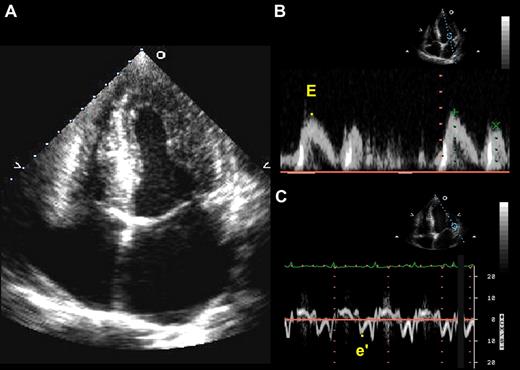In adults with sickle cell disease (SCD), echocardiographic evidence of diastolic dysfunction is an independent risk factor for death that is additive to pulmonary hypertension.1 In this issue of Blood, Johnson and colleagues describe echocardiography and polysomnography results from 44 children with SCD. Because their echocardiograms were ordered for clinical indications, potentially biasing toward more symptomatic patients, the reported prevalence of increased left ventricular mass should be interpreted with caution. Nevertheless, the results demonstrate left ventricular hypertrophy and diastolic dysfunction significantly correlating with low TcO2, both asleep and awake, and with systolic blood pressure.2 This confirms the association of left ventricular hypertrophy, diastolic dysfunction, and low waking TcO2 in 310 children with SCD reported by Dham et al.3
Low transcutaneous oxygen saturation (TcO2) in patients with sickle cell disease (SCD) has long been of concern to hematologists. Desaturations are explained by obstructive sleep apnea in only a minority of cases and have been associated with markers of activated endothelium, platelets and leukocytes, leukotriene B4, high von Willebrand factor, low hemoglobin, and high reticulocyte count.4,5 Johnson et al show in this issue that sleep and waking TcO2 are equally strong correlates of diastolic dysfunction in children with SCD, in agreement with their previous publication correlating awake and nocturnal TcO2.6 Although in their study of 44 patients, Johnson et al observe only a trend toward a link between low saturation and high tricuspid regurgitation velocity, an echocardiographic marker of pulmonary arterial pressure, this association has been confirmed more definitively in previous larger studies of 117 adults (P = .002) and 391 children (P = .003) with SCD.7,8 It is unclear whether low TcO2 is a cause or result of these cardiovascular changes.
Representative echocardiographic images from a patient with sickle cell disease. (A) Apical 4-chamber view showing concentric left ventricular hypertrophy and a dilated left atrium. (B) Doppler of the mitral inflow used to obtain a peak E velocity for early ventricular filling. (C) Tissue Doppler of the lateral mitral annulus used to obtain a peak e′ velocity. The E/e′ ratio is an indicator of left ventricular filling pressures and is used in the assessment of diastolic dysfunction.
Representative echocardiographic images from a patient with sickle cell disease. (A) Apical 4-chamber view showing concentric left ventricular hypertrophy and a dilated left atrium. (B) Doppler of the mitral inflow used to obtain a peak E velocity for early ventricular filling. (C) Tissue Doppler of the lateral mitral annulus used to obtain a peak e′ velocity. The E/e′ ratio is an indicator of left ventricular filling pressures and is used in the assessment of diastolic dysfunction.
In the general adult population, left ventricular hypertrophy and diastolic dysfunction have clearly been linked to systemic hypertension. The resting blood pressure range is lower among persons with SCD than in the general population, but Pegelow and others have documented in sickle cell patients that relative systemic hypertension that still falls within population norms predicts early mortality.9 Johnson et al's study supports this concept with their multivariate analysis showing that systolic blood pressure percentiles are independent predictors of left ventricular mass index. The association of relative systolic hypertension and adverse clinical outcomes is a repetitive theme in SCD, meriting deeper investigation and treatment trials.
Finally, the current SCD paper links together the constellation of desaturation, hypertension, and diastolic dysfunction, although the causative sequence remains to be established. In adults without SCD, a similar syndrome that involves obstructive sleep apnea is a risk factor for cardiovascular disease.10 This syndrome is often linked to obesity, hypoxia, sympathetic activation, endothelial dysfunction, oxidative stress, and inflammation. The striking partial overlap between these 2 syndromes of intermittent/chronic hypoxia, hypertension, and diastolic dysfunction invites additional comparisons and more detailed research.
Conflict-of-interest disclosure: The authors declare no competing financial interests. ■
REFERENCES
National Institutes of Health


This feature is available to Subscribers Only
Sign In or Create an Account Close Modal